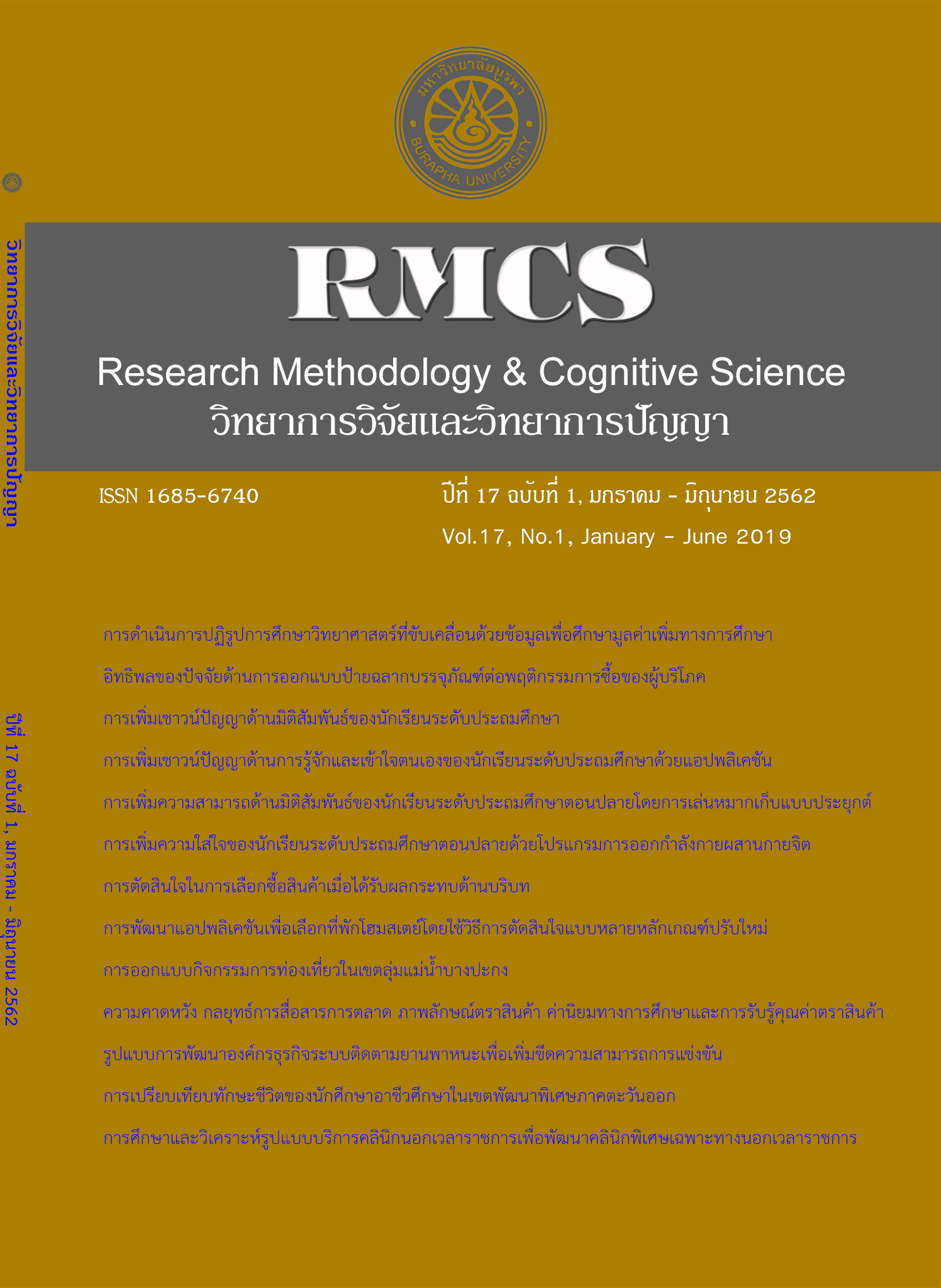การเพิ่มความสามารถด้านมิติสัมพันธ์ของนักเรียนระดับประถมศึกษาตอนปลาย โดยการเล่นหมากเก็บแบบประยุกต์
Main Article Content
บทคัดย่อ
การวิจัยนี้มีวัตถุประสงค์เพื่อพัฒนาการเล่นหมากเก็บแบบประยุกต์สำหรับเพิ่มความสามารถด้านมิติสัมพันธ์ของนักเรียนระดับประถมศึกษาตอนปลาย โดยเปรียบเทียบผลการเพิ่มความสามารถด้านมิติสัมพันธ์ของกลุ่มรับ
การเล่นหมากเก็บแบบประยุกต์กับกลุ่มที่ไม่ได้รับการเล่นหมากเก็บแบบประยุกต์ด้วยวิธีการเปรียบเทียบ
ความถูกต้องของการตอบและเวลาปฏิกิริยา ความสูงและความกว้างของคลื่นไฟฟ้าสมอง P300 กลุ่มตัวอย่างเป็นนักเรียนระดับประถมศึกษาตอนปลาย เพศชายและเพศหญิง อายุ 10-12 ปี จำนวน 60 คน สุ่มเข้ากลุ่มทดลองและกลุ่มควบคุม ด้วยวิธีการสุ่มอย่างง่าย เครื่องมือที่ใช้ในการวิจัยประกอบด้วย หมากเก็บแบบประยุกต์ที่ผู้วิจัยสร้างขึ้น กิจกรรมทดสอบความสามารถด้านมิติสัมพันธ์ (Spatial ability task) ที่ประกอบด้วยภาพสัตว์จำนวน 16 ข้อ และรูปทรงเรขาคณิต จำนวน 16 ข้อ รวม 32 ข้อ และเครื่องตรวจวัดคลื่นไฟฟ้าสมอง วิเคราะห์ข้อมูลด้วยค่าความถี่ ร้อยละ ค่าเฉลี่ย ส่วนเบี่ยงเบนมาตรฐาน และสถิติ t-testแบบอิสระต่อกัน
ผลการวิจัยปรากฏว่า
- ผลการเปรียบเทียบความถูกต้องของการตอบและเวลาปฏิกิริยา ขณะทำกิจกรรมทดสอบความสามารถด้านมิติสัมพันธ์ กลุ่มทดลอง มีคะแนนความถูกต้องมากกว่ากลุ่มควบคุมและเวลาปฏิกิริยา น้อยกว่ากลุ่มควบคุม อย่างมีนัยสำคัญทางสถิติ แสดงว่า การเล่นหมากเก็บแบบประยุกต์ สามารถเพิ่มความสามารถด้านมิติสัมพันธ์ของกลุ่มทดลองได้
- ผลการเปรียบเทียบความสูงและความกว้างของคลื่นไฟฟ้าสมอง P300 ขณะทำกิจกรรมทดสอบความสามารถด้านมิติสัมพันธ์ ระหว่างกลุ่มทดลองกับกลุ่มควบคุม กลุ่มทดลองมีความสูงของคลื่นไฟฟ้าสมอง P300 มากกว่ากลุ่มควบคุม ที่ตำแหน่งอิเล็กโทรด ดังนี้ F3 C6 P6 P1และ POZ และความกว้างของคลื่นไฟฟ้าสมอง P300น้อยกว่ากลุ่มควบคุม ที่ตำแหน่งอิเล็กโทรด CP5 สรุปได้ว่า การเล่นหมากเก็บแบบประยุกต์สามารถเพิ่มความสามารถด้าน
มิติสัมพันธ์ของนักเรียนระดับประถมศึกษาได้
Article Details
เอกสารอ้างอิง
ปริญญา เรืองทิพย์ และเดชา วรรณพาหุล. (2557). การพัฒนาความสามารถด้านมิติสัมพันธ์ของนักเรียนชั้นมัธยมศึกษาตอนปลาย โดยการเล่นเกมชุโดกุ. วารสารราชนครินทร์, 11(25), 35-41.
มรดกภูมิปัญญาทางวัฒนธรรม. (2561). หมากเก็บ. วันที่สืบค้นข้อมูล 7 มกราคม 2561. เข้าถึงได้จาก http://ich.culture.go.th/index.php/th/ich/folk-sports-games-and-martial-arts/261
Agam, Y., &Sekuler, R. (2007). Interactions between working memory and visual perception: An ERP/EEG study.Neuroimage,36(3), 933-942.
Akarsu, S., Çaliskan, E., & Dane, Ş. (2009). Athletes have faster eye-hand visual reaction times and higher scores on visuospatial intelligence than non-athletes. Turkish Journal of Medical Sciences, 39(6), 871-874.
Alloway, T. P., Bibile, V., & Lau, G. (2013). Computerized working memory training: Can it lead to gains in cognitive skills in students?Computers in Human Behavior, 29(3), 632-638.
Baddeley, A. (2010). Working memory. Current Biology, 20(4), 136-140.
Baddeley, A. (2012). Working memory: Theories, models, and controversies.Annual Review of Psychology,63, 1-29.
Bird. C. M., & Burgess, N. (2008). The hippocampus and memory: Insights from spatial processing. Nature Reviews Neuroscience, 9, 182-194.
Blüchel, M., Lehmann, J., Kellner, J., & Jansen, P. (2013). The improvement in mental rotation performance in primary school-aged children after a two-week motor-training. Educational Psychology, 33(1), 75-86.
Christou, C., Pittalis, M., Mousoulides, N., Pitta, D., Jones, K., Sendova, E. &Boytchev, P.(2007). Developing an Active Learning Environment for the Learning of Stereometry. In proceeding of the 8th International Conference on Technology in Mathematics Teaching (ICTMT8), Hradec Králové: University of Hradec Králové.
Cohen, C. A., & Hegarty, M. (2014). Visualizing cross sections: Training spatial thinking using interactive animations and virtual objects. Learning and Individual Differences,33, 63-71.
Conroy, M. A., &Polich, J. (2007). Affective valence and P300 when stimulus arousal level is controlled. Cognition and Emotion,21(4), 891-901.
Davis, C. L., Tomporowski, P. D., Mcdowell, J. E., Austin, B. P., Miller, P. H., Yanasak, N. E., Allison, J. D., Naglieri, J. A. (2011). Exercise improves executive function and achievement and alters brain activation in overweight children: A randomized, controlled trial. Health Psychology: Official Journal of the Division of Health Psychology. American Psychological Association, 30, 91-98.
Edmonds, W, A., & Kennedy, T, D. (2017). An Applied Reference Guide to Research Design: Quantitative, Quanlitative and Mixed Methods. California: SAGE Publications.
Farber, D. A., &Sinitsyn, S. V. (2009). Functional organization of working memory in seven- to eight-year-old children. Human Physiology,35(2), 131-141.
Gerber, P., Schlaffke, L., Heba, S., Greenlee, M. W., Schultz, T., & Schmidt-Wilcke, T. (2014).Juggling revisited-A voxel–based morphometry study with expert jugglers. Neuroimage, 95, 320-325.
Jansen, P., Titze, C., & Heil, M. (2009). The influence of juggling on mental rotation performance. International Journal of Sport Psychology, 40, 351-359.
Kosslyn, S. M., Shephard, J. M., & Tomson, W. L. (2007). Spatial processing during mental image: A neurofunctional theory. In Mast, F. &Jancke, L. (Eds.), Spatial Processing in Navigation, Imagery and Perception (pp.1-15). New York, USA: Springer.
Lutz, H. (2014).Life Kinetik. GehirntrainingdurchBewegung. München, Germany: BLV.
Neokleous, K. C., &Schizas, C. N. (2011). Computational modeling of visual selective attention.Procedia Computer Science,7, 244-245.
Neuburger, S., Jansen, P., Heil, M., &Quaiser-Pohl, C. (2011). Gender differences in pre-adolescents’ mental-rotation performance: Do they depend on grade and stimulus type?.Personality and Individual Differences, 50(8), 1238-1242.
Pietsch, S., Böttcher, C., & Jansen, P. (2017). Cognitive Motor Coordination Training ImprovesMental Rotation Performance in Primary School-Aged Children. Mind, Brain & Education, 11(4), 176–180.
Polich, J., &Kok, A. (1995). Cognitive and biological determinants of P300: An integrative review. Biological Psychology, 41(2), 103-146.
Schneck, C. M. (2010). A frame of reference for visual perception. In Kramer, P. &Hipnojosa, J. (Eds.), Frame of reference for pediatric occupational theory (3rded., pp. 349-389). USA: Lippincott Williams & Wilkin.
Scholz, L., Klien, M. C., Behrens, T. E., Johansen-Berg, H. (2009). Training induces changes in white-matter architecture. Nature Neuroscience, 12, 1370-1371.
Seidler, R. D. (2010). Neural correlates of motor learning, transfer to learning, and learning to learn. Exercise and Sport Science Reviews, 38, 3-9.
Shepard, R. N., & Metzler, J. (1971). Mental rotation of three-dimensional objects. Science,171(3972), 701-703.
Sibley, B.A., Etnier, J.L. (2003). The relationship between physical activity and cognition in children: A meta-analysis. Pediatric Exercise Science, 15, 243-256.
Snodgrass, J. G., &Vanderwart, M. (1980). A standardized set of 260 pictures: Norms for name agreement, image agreement, familiarity, and visual complexity. Journal of experimental psychology: Human Learning and Memory, 6(2), 174-215.
Rizzolatti, G., &Luppino, G. (2001). The cortical motor system. Neuron, 31(6), 889-901.
Ung, P., &Kornpetpanee. S. (2560). Development of a Three-Dimensional Multiple-Moving Block Tracking Model (3D-MBTM) for Enhancing Spatial Ability in Early Adolescence. Research Methodology and Cognitive Science, 15(2), 12-24.
Vandenberg, S. G., &Kuse, A. R. (1978). Mental rotations, a group test of three-dimensional spatial visualization. Perceptual and Motor Skills,47(2), 599-604.
Wheeler, M. E., &Treisman, A. M. (2002). Binding in short-term visual memory.Journal ofExperimental Psychology: General,131(1), 48-64.
Wintink, A. J., Segalowitz, S. J., & Cudmore, L. J. (2001). Task complexity and habituation effects on frontal P300 topography. Brain and Cognition,46(1-2), 307-311.

